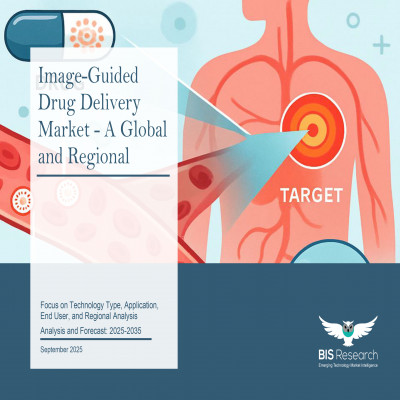Introduction to Europe Image-Guided Drug Delivery Report
The Europe image-guided drug delivery market is projected to reach $284.1 million by 2035 from $13.7 million in 2024, growing at a CAGR of 32.01% during the forecast period 2025-2035. Therapeutics are delivered directly to illness areas, such as tumors and neurological regions, in Europe through Image-Guided Drug Delivery (IGDD), which uses sophisticated, precision-focused, minimally invasive procedures. This novel strategy represents a change from traditional systemic treatments to more patient-specific, localized, and safe approaches. With the use of robots and AI-guided navigation, IGDD enables physicians to deliver chemotherapeutics, gene therapies, and cell-based treatments with remarkable precision by fusing specialized delivery tools like catheters and cannulae with imaging platforms like MRI, CT, and ultrasound. The technique improves treatment results, lowers systemic toxicity, speeds up recuperation, and maximizes healthcare effectiveness, making IGDD a crucial component of Europe's precision medicine scene.
Market Introduction
The growing use of IGDD systems throughout Europe and developments in sophisticated imaging drug delivery technologies are fueling the market's explosive expansion in Europe. By precisely delivering medications to specific disease sites, such as tumors and brain areas, these devices lower systemic toxicity and enhance patient outcomes. Investments in cutting-edge drug delivery platforms that combine MRI, CT, PET, and ultrasound imaging with minimally invasive treatments are being driven by the rising need for targeted medication delivery and precision medicine in Europe.
In Europe, image-guided drug delivery applications are predominantly seen in oncology, neurology, and wound healing, with oncology leading due to rising cancer prevalence. The aging of Europe's population, the rise in chronic illnesses, and continuous improvements in imaging-guided drug delivery technologies all contribute to the market's expansion. Additionally, IGDD systems are being adopted more quickly in Europe thanks to government financing for healthcare innovation and favorable regulatory support, making these technologies a crucial component of next-generation precision medicine solutions.
With substantial R&D expenditures in precision-targeted drug delivery technology and established healthcare infrastructure, Germany, France, and the United Kingdom dominate the European image-guided drug delivery industry. Because of increased access to and awareness of healthcare, emerging economies in Eastern Europe are progressively implementing IGDD systems. However, obstacles including high upfront costs, complicated regulations, technical constraints, and privacy concerns about patient data still hinder market penetration and broad adoption.
The Europe IGDD market is projected to achieve strong growth over the next decade, driven by continuous technological advancements and the increasing emphasis on personalized drug delivery. Integrating AI-driven navigation, robotics, and imaging technologies will enhance therapeutic precision, reduce recovery times, and optimize healthcare resources, positioning Europe as a leader in next-generation precision medicine and targeted drug delivery solutions.
Market Segmentation:
Segmentation 1: By Technology Type
• Drug-Delivery Systems
• Image-Guided Platforms
Segmentation 2: By Application
• Oncology
• Neurology
• Others
Segmentation 3: By End User
• Hospitals
• Pharmaceutical & Biotechnology Companies
• Contract Research Organizations (CROs)
• Research Institutes & Universities
Segmentation 4: By Region
• Europe
o Germany
o U.K.
o France
o Italy
o Spain
o Rest-of-Europe
Europe Image-Guided Drug Delivery Market Trends, Drivers and Challenges
Market Trends
• Technological Advancements: Integration of imaging modalities such as MRI, CT, PET, and ultrasound with drug delivery systems is enhancing the precision and efficacy of treatments, particularly in oncology and neurology.
• Minimally Invasive Procedures: There is a growing preference for minimally invasive techniques, leading to increased adoption of image-guided therapies that offer reduced recovery times and improved patient outcomes.
• Personalized Medicine: The shift towards personalized treatment plans is fostering the development and adoption of IGDD systems tailored to individual patient profiles.
• Regulatory Support: European regulatory bodies are providing clearer pathways for the approval of innovative drug delivery technologies, facilitating market growth.
Market Drivers
• Rising Incidence of Chronic Diseases: The increasing prevalence of conditions such as cancer and neurological disorders is driving demand for targeted and effective treatment options.
• Advancements in Imaging Technologies: Continuous improvements in imaging modalities are enhancing the accuracy and reliability of IGDD systems, making them more appealing to healthcare providers.
• Aging Population: Europe’s aging demographic is contributing to a higher incidence of age-related diseases, thereby increasing the need for advanced drug delivery solutions.
• Healthcare Infrastructure: Well-established healthcare infrastructure and a high level of medical expertise in Europe are conducive to the adoption of advanced drug delivery systems.
• Government Initiatives: Supportive government policies and funding for medical research are accelerating the development and implementation of IGDD technologies.
Market Challenges
• High Costs: The initial investment and maintenance costs of IGDD systems can be prohibitive, limiting their accessibility, especially in smaller healthcare facilities.
• Regulatory Hurdles: Navigating the complex regulatory landscape for medical devices and drug delivery systems can delay market entry and adoption.
• Technical Limitations: Challenges related to the integration of imaging and drug delivery technologies, as well as issues with device calibration and standardization, can impact the effectiveness of IGDD systems.
• Patient Awareness: Limited patient awareness and understanding of IGDD therapies can hinder acceptance and utilization of these advanced treatment options.
• Data Privacy Concerns: The use of imaging data in drug delivery raises concerns regarding patient data privacy and security, necessitating stringent compliance with data protection regulations.

